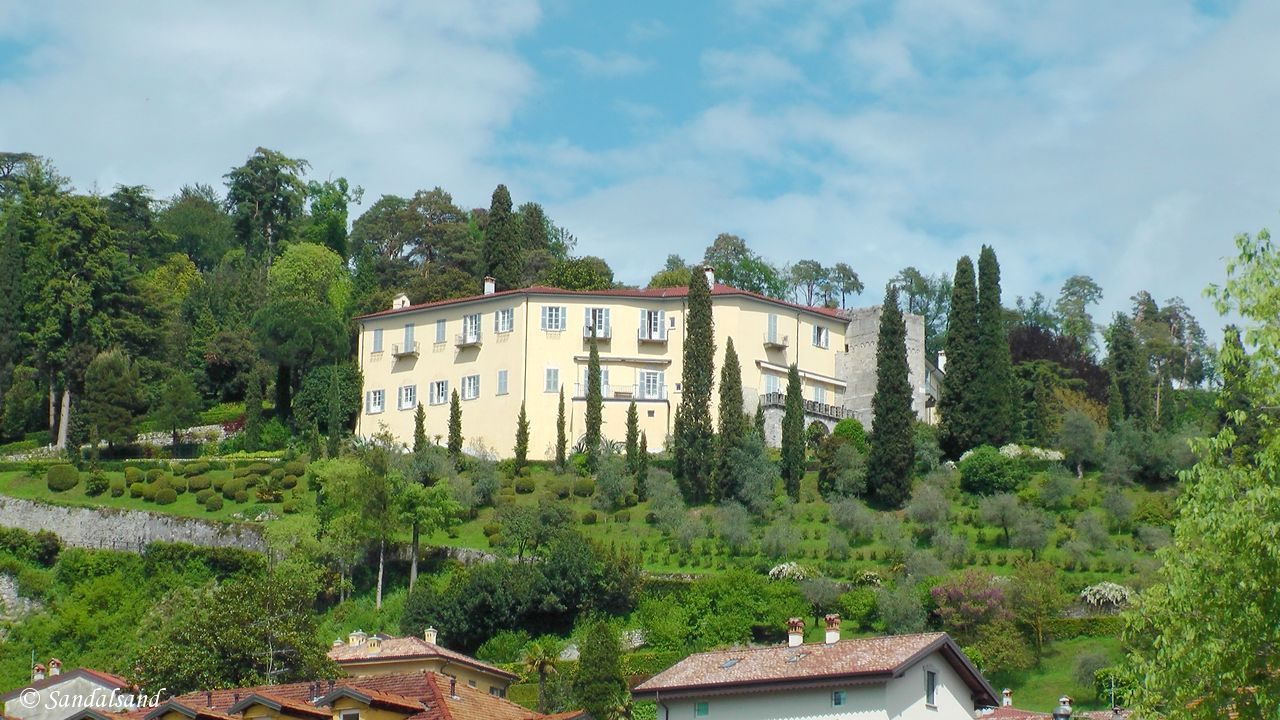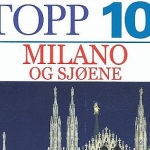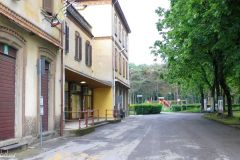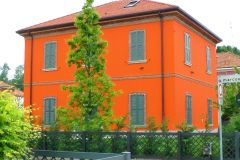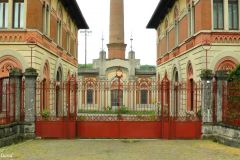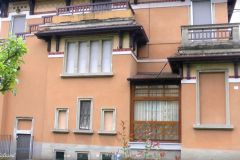We went on a football trip to Milan’s San Siro stadium and started with complementary visits to the beautiful Lakes Region. We first went to Lago di Como, the hidden World Heritage gem of Crespi d’Adda before the exciting city of Milan.
Planning the perfect weekend
Why plan?
The combination of a big city and a big football stadium makes a perfect weekend trip. I have over the years had a few of them: Madrid, London, Barcelona, Manchester, and Liverpool. Combining the interests of a birthday present to my 18-year old son and our mutual interest, football, made Milan a natural choice. Booking a three-night stay made it obvious that we had some free time to fill.
My guidebook to Milan was a Norwegian translation of DK Eyewitness Top 10 Travel Guide to Milan and the Lakes.
I set about planning for the stay, consulting my son, and quickly landed on a rough itinerary.
Part 1
Landing early on day 1 at the Malpensa Airport outside Milan we had time to visit the region by car.
- It is almost inevitable that the lakes of northern Italy was important to visit. There are many of them (Maggiore, Lugano, Como, Iseo, Garda) but I decided on Lago di Como for its acclaimed beauty and location for us.
- The next step was to follow my invisible World Heritage List trail: The unknown Crespi d’Adda came up.
- Of interest to father and son was the Monza Formula 1 racing track, the world’s most famous.
Part 2
Days 2 and 3 were to be in Milan city, or Milano as I would have preferred to call it. That stay is described in another entry. The map shows where we went. View 2013 Milano on Sandalsand’s travel map.
An excursion to the beautiful lake of Lago di Como
From Malpensa airport to Como
We had booked a car with a rental agency, but the waiting line was long and there was trouble with my booking. We got off late and steered north-east on good roads. The rain was pouring down. My guidebook stated that Lake Como was the most beautiful of the northern Italian lakes. In addition it was well positioned for our round trip as seen on the map above. My guidebook also offered the suggestion of taking a boat trip on the lake, to get a better view of the mountains, villages and elegant villas. We dropped this advice and headed straight for the town named after the lake, or vice versa.
With the rain still pouring we had a slight problem finding our way to and through the centre of Como Town. Not equipped with a good map, we believed we had missed it when all of a sudden the rain stopped, a multi-storey car-park came up and upon exiting it we realised we had hit the city centre spot on.
We walked a series of nice little pedestrian streets and found ourselves right in front of the town’s most famous sight, the cathedral. We skipped the other sights (a couple of museums, two old churches and the shops) and had a look inside the really nice cathedral. This old silk capital of Italy was established by the Romans but we came across no ruins from that time. The architecture was more Renaissance style.
Continuing on to Bellagio
After a pizza on the piazza we ventured down to the shore of Lake Como and looked out the lake. The Lago di Como has the shape of a two-tined fork (or letter Y) turned upside down. Como Town is situated at the tip of the western tine. There were some really nice views up the mountains with large villas (palaces) perched on top, and around town.
Right on the tip of the peninsula, or should I say between the fork tines, there is a quite famous village. The village is called Bellagio. In fact I had read somewhere that it was Europe’s most beautiful village. I suppose there are many contenders to that title, but it seemed promising. In any case we were heading that way, aiming at passing through the village before turning south on the eastern tine of the fork.
The lake is about 50 km long and for the most part less than 2 km wide. The drive along the lake was extremely scenic. The mountains were majestic, some with patches of snow on the summit, the lake was deep blue, the small hamlets were as picturesque they ever could be, and the sun was shining. We had a great drive with surprisingly little traffic. The only drawback was that the road was very narrow, and very winding all 30 km from Como to Bellagio. At one point we met four Ferraris in a row, then two more a moment later. They might have been on a photo-shoot.
Driving our plain Fiat Punto we missed many of the beautiful villas on our side of the lake, but we had a good view across to the other side, including the famous Villa Balbaniello, of James Bond and Star Wars fame. (Not the one below.)
Town of Bellagio
Bellagio was at least as lovely as promised. The sun was shining on splendid villas and gardens, narrow and steep hillside streets, and on the line of cafés on the waterfront. The view up north, towards the snow-capped Swiss Alps was impressive. If you thought that the Vegas’ casino named Bellagio was the real thing, think again. The rich has since the Romans been visiting Bellagio. We were not in the main season, but there were plenty of tourists nonetheless.
We headed south on our road-trip into the eastern tine of Lake Como. Finding our way was quite easy, but upon reaching the end of the lake at Lecco, we failed to spot the right road signs. That next leg took us two hours instead of the expected 70 minutes. At the end I had to start my Google Maps app and let Google’s lady voice direct my steering. It worked very well.
An excursion to the obscure Crespi d’Adda
A World Heritage
Planning my visit to Milan and today’s car trip I had discovered that of all 47 World Heritage Sites in Italy, only two were located in or at a reasonable distance from Milan. Inside the city there is the “Last Supper“, the extremely acclaimed and famous painting by Leonardo da Vinci. The other heritage site is Crespi d’Adda, of which I had never heard before. Browsing a few guidebooks was of no help: Crespi d’Adda was not even mentioned. The best source of information was the web page of the heritage site itself.
UNESCO describes this site like this: “Crespi d’Adda in Capriate San Gervasio in Lombardy is an outstanding example of the 19th- and early 20th-century ‘company towns’ built in Europe and North America by enlightened industrialists to meet the workers’ needs. The site is still remarkably intact and is partly used for industrial purposes, although changing economic and social conditions now threaten its survival.”
What does it look like? Here are some photos up front, then read more below.
The family
The Crespis were a family of industrialists intent on not only creating business but also on taking care of their workers. To this end they built a cotton mill factory, a school, hospital, cemetery, grocery store, houses for workers and villas for the functionaries. In addition to a castle for themselves. Everything was planned, everything was neatly laid out, and every need was taken care of in this cradle to grave microcosm.
It is today the best preserved “company town” in Southern Europe, but it is by no means unique compared to the rest of Europe. The factory is closed, the hospital likewise. The houses are still in use, and some of the residents had their ancestors working in the factory. Crespi d’Adda is a very fascinating place, less than an hour east of Milan.
“Crespi d’Adda” is no. 730 on UNESCO’s World Heritage List. It is an outstanding example of the 19th- and early 20th-century ‘company towns’ built in Europe and North America by enlightened industrialists to meet the workers’ needs.
Epilogue
By the time we were finishing our visit to Crespi d’Adda the clock had ticked past six in the afternoon. Facing a two hour drive back to the airport, and another hour on the train into Milan, we had to skip our planned visit to the Monza racing track. It’s not far though from the main motorway (A4/E64). Handing back the car was a swift affair, as was the direct train linking Malpensa Airport with Stazione di Milano Centrale.
In Milan all seven heavens must have opened their locks simultaneously. They emptied oceans of water over our heads. The great halls of the colossal central station were packed with people waiting for the rain to stop. The station is often viewed as an example of monumental fascist architecture, but its drawings date back to 1912. In any case, being Norwegians, we ducked into the rain and after a few unforgivable wrong turns made it into the lobby of our hotel. By then the rain had stopped and we were soaking wet.
Read more
Crespi d’Adda, the World Heritage Site.
Days 2 and 3 of this trip to Milan.
